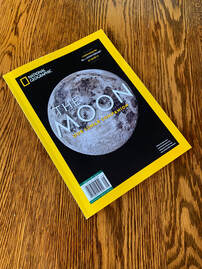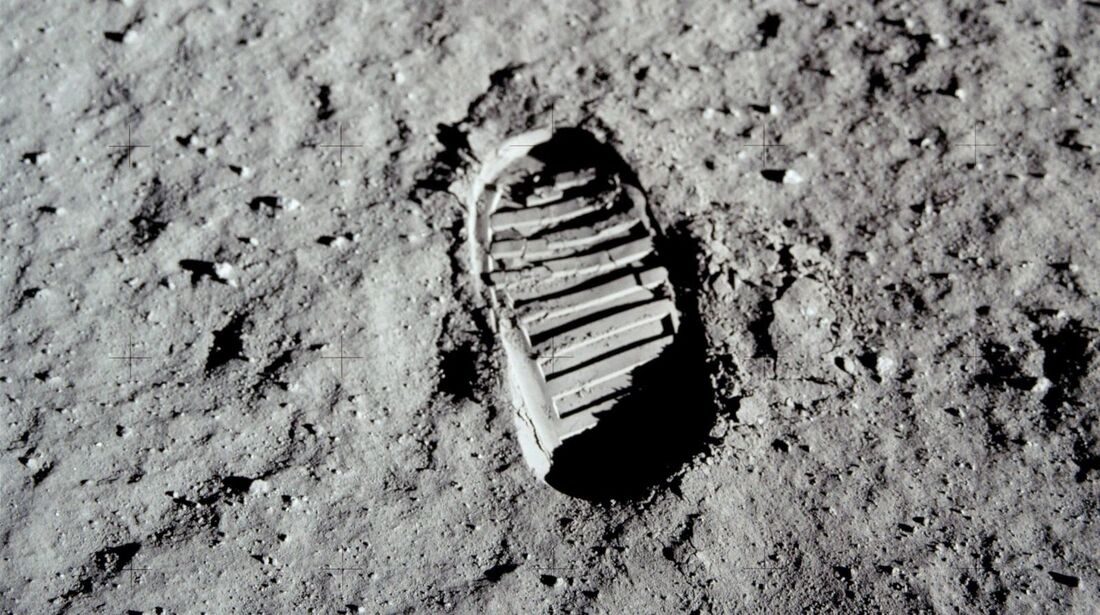Almost immediately, Armstrong set about collecting samples of "moon dust" from multiple locations. Twenty minutes later, he was joined by his fellow astronaut Edwin "Buzz" Aldrin, who also began collecting samples. In all, two and a half hours were spent collecting 2.2 pounds of material. They also deployed a seismometer to detect possible tremors and an optical reflector used to measure the distance between Earth and Moon with even greater accuracy. To mark the symbolic importance of the achievement, they planted an American flag along with a plaque that read, "Here men from the planet Earth first set foot on the moon.... We come in peace for all mankind."
The two then climbed back into the Eagle, napped for a few hours, and rejoined pilot Michael Collins in the Columbia command module to begin their journey home. On July 24 - eight days, three hours, 18 minutes and 35 seconds after liftoff - the mission ended in splashdown in the Pacific, where the three astronauts were recovered by the USS Hornet. They then remained in quarantine for three weeks, just to be sure they hadn't brought back any extraterrestrial microorganisms, before they were allowed to return to their homes, and to the ticker tape parades that awaited them.
Between 1969 and 1972 there were five more successful moon landings, during which ten more astronauts walked on the moon. One more crewed mission (Apollo 13) orbited the moon in 1970 without landing and returned under harrowing circumstances after an explosion in an oxygen tank crippled the spacecraft, riveting public attention and leading to a radio transmission even more memorable than "one giant leap for mankind": "Houston, we've had a problem" (commonly misquoted as in the 1995 movie Apollo 13, "Houston, we have a problem").
No one has been back to the moon since 1972.

How could I resist?
The volume begins with words about the sway the moon has always held over the human imagination and culminates in a detailed look at the first moonwalk on July 20, 1969, the succeeding three and one half years of human exploration, and their enduring legacy. The intervening chapters offer an overview of the history of the scientific study of the moon, starting in 1609 with Thomas Harriot’s observations with an early version of the telescope.
As I thumbed through its pages, looking for but not finding a reference to that other moon shot just 23 years earlier, it occurred to me to wonder what, if anything, we learned about the moon from Project Diana. Most contemporary reports on Project Diana focused on the remarkable innovations in the equipment - the transmitter, antenna, and receiver - that made it possible for the project to succeed in bouncing radar waves off the moon when all previous attempts, including one by Project leader Jack DeWitt himself in 1940, had failed. But did we actually learn something about the moon itself that might have served as the basis for the generation of new knowledge? Something that might have helped pave the way for the lunar landing?
In an oral history interview I conducted with my father in 1979, he remarked on the excitement generated by the success of Project Diana and I asked how it compared with Apollo 11. "Well, it was much less than that in magnitude. But philosophically and sociologically, I think it was important, because as far as I know, it really was the first time that man had in a measurable way [italics mine] manifested his influence beyond the reaches of the immediate locale of the earth. Indeed, somebody on the moon could have received radio signals that were transmitted from the earth, but this was really the first proof of it."
According to the History of Army Communications and Electronics at Fort Monmouth, New Jersey, 1917-2007 (published 2008), Dr. Walter McAfee, who made the mathematical calculations for the moon shot, also downplayed the comparison in a 1985 interview, stating that the Project Diana scientists were thinking more about the utility of their work in propagating radio waves than in going to the moon. Nevertheless, he added, the experiment improved our ability to measure the distance between the earth and the moon and led to some understanding about the nature of the surface of the moon.
First, as both my father and Dr. McAfee noted, by pioneering a technique of active observation that involved reflecting microwaves off the moon and analyzing the reflected signal - radar astronomy - the Project Diana team developed the most accurate method to date for measuring the distance between the earth and the moon. By extension, and of critical importance for the future of space exploration, Project Diana also showed that the distance and velocity of a spacecraft could be determined very accurately from the earth. Even though the Columbia's onboard navigation system would probably have been adequate for that purpose, the ground-based method was still unsurpassed in accuracy and therefore the main method used to track the Apollo 11 spacecraft.
Second, as Dr. McAfee mentioned, Project Diana contributed to what was then known about the nature of the moon's surface and played at least a cameo role in a subsequent debate on the topic. To be clear, he was not talking about mapping the topography of the moon, which could not have been done with the equipment they were using at the time. The team was, however, seriously concerned about reflective properties of the moon that might need to taken into account when using it as a radar target, as discussed at some length by DeWitt and Stodola in their 1949 paper. If the moon was perfectly smooth, the reflection would be expected to be comparable to light bouncing off a mirror. From what limited astronomical evidence existed, however, they inferred that the terrain would more likely consist of plains and mountains similar to earth - perhaps somewhat rougher due to the lack of water and air to produce "weathering." They used experimental data from tests of a mountainous area near Ellenville, New York, probably obtained during the development of methodology to distinguish low-flying kamikaze planes from ground clutter,
to adjust their signal transmission and reception parameters.
Later, as radar reflections became somewhat more refined, a serious controversy developed, fueled by a theory proposed by Cornell scientist Thomas Gold that the moon was covered by a fine layer of dust or "lunar regolith" that might be deep enough to swallow an astronaut or even a spaceship like quicksand. It wasn't until 1966-68 that a series of Surveyor probes sent to investigate the nature of the moon's surface landed successfully and satisfied NASA scientists that the moon's surface was well-enough compacted to support the weight of an astronaut. So Gold was right about the lunar regolith, it turned out, but not about the quicksand (which for some reason was a disproportionate and almost obsessive fear during that era - someone calculated that 1/3 of movies made in the 1960s included at least a passing reference to quicksand). The assumption under which the Project Diana team operated, it turned out, was closer to the truth.
Even so, the astronauts remained understandably nervous about the ability of the moon's surface to support not only themselves but also their landing module, which was equipped with legs designed to serve as a built-in launchpad. This was, after all, their only option for getting off the moon. The Eagle had to work right the first time, without benefit of a full dress rehearsal, and there was no rescue plan if it failed. The astronauts knew this. (What they didn't know is that in the event they were stranded, all communication with them would be cut to avoid sharing the last words of the doomed duo with a watching world.)
Jack DeWitt’s original assignment was to research and test the capabilities of long-range radar to determine its utility for detecting incoming ballistic missiles. It was not intended as a hypothesis-testing experiment but rather as a demonstration project, or perhaps more accurately a proof of concept. DeWitt decided to fulfill this assignment by “shooting the moon” - a longstanding dream that he justified by arguing that it was the obvious and in fact the only available target for making such a test.
This decision was truly a stroke of genius. It transformed the project from a military exercise to something much broader in scope and interest, something that captured the world’s imagination. “Somehow,” the New York Times declared, “the moon and all the heavenly bodies become more real…more than a guide to navigators and an inspiration to poets…tangible objects to which we can reach out." The success of Project Diana resolved any remaining doubts about whether radar could penetrate the ionosphere. It revolutionized wireless communication. But more than that, the inspirational and aspirational elements of the project dynamized future research by emboldening scientists to consider such new and exciting possibilities as artificial satellites, space probes, and yes, human spaceflight, in the process garnering widespread public support for such efforts in ways that have been well-documented here and elsewhere.
- - - - - - - - - -
(Thanks to Drs. Ovide Pomerleau and Gregory Wright for their assistance. Any errors are mine, not theirs.)


 RSS Feed
RSS Feed